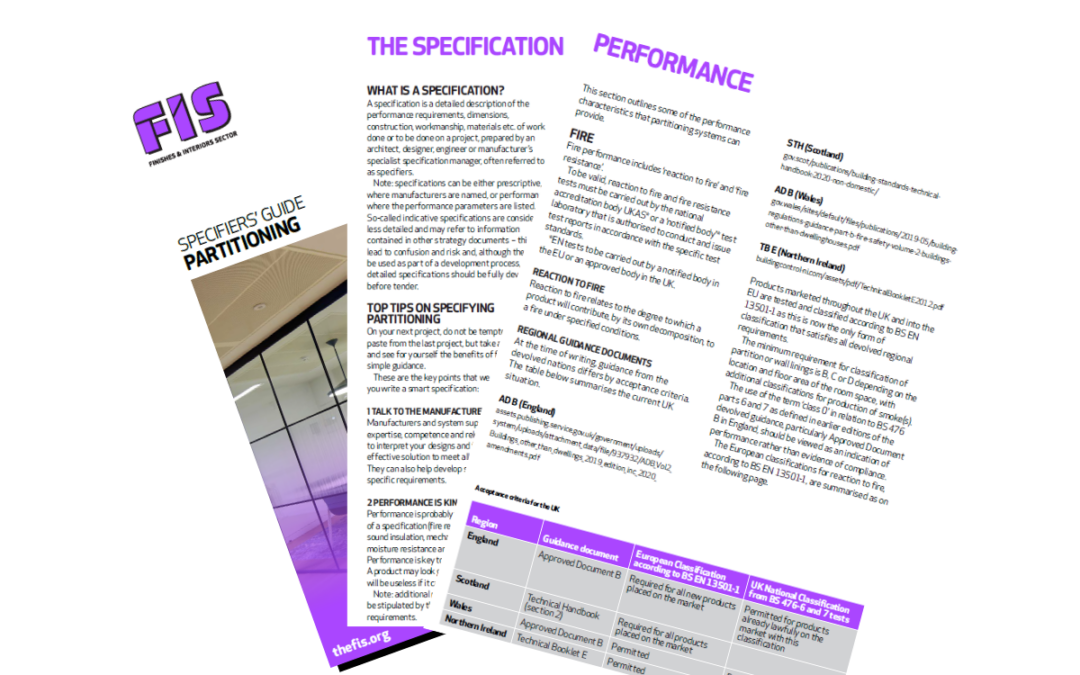
by Clair Mooney | 12 May, 2022 | Building Safety Act, Technical
Developers in Scotland will be banned from using combustible cladding on high‐rise buildings from 1 June, following the introduction of new building standards legislation. Since 2005, new cladding systems on high‐rise blocks of flats have either had to use non‐combustible materials or pass a large‐scale fire test. However, the new legislation removes the option of the fire test, prohibiting such materials from being used on domestic and other high‐risk buildings above 11 metres. The highest risk metal composite cladding material will be banned from all new buildings whatever their height, with replacement cladding also required to meet the new standards.
FIS has reviewed the proposals and note that Cavity Trays that caused some disruption in England and Wales are in the list of exemptions and consistent with the work we did with Scottish Government on buildings greater than 18 m.
Scottish Procurement Policy Note (SPPN) 02/2022 will also be introduced from 1 June, which sets out how public sector bodies are to embed prompt payment performance in the supply chain through procurement processes. Suppliers will have to pay 95% of valid invoices on time, or provide an improvement plan, otherwise they will not be selected to bid.

by Clair Mooney | 5 May, 2022 | Technical
FIS has launched a technical guidance note, Guarding with frameless glass partitioning to help specifiers, designers, manufacturers and specialist contractors fully understand the unique challenges of utilising full height frameless glazed partitions as a barrier.
The new FIS technical note was produced by the FIS on behalf of its members and peer reviewed by the wider community in response to ongoing feedback on the specific overlap between this product category and it’s intended use which is not well described or prescribed by standards or regulations. The document also gives examples of how to harmonise the approach to performance across devolved nations where the guidance that exists can vary.
Commenting on the need for guidance Peter Long of Optima Systems said:
“We need to be advocating the same degree of risk management in guarding as we do with fire. Both areas of construction are protecting risks to life, so both should have the same levels of attention to safe design.”
This supports the need to consider this product to be a clear example of a safety critical product.
Referenced and associated FIS publications:
The unintentional designer
Spontaneous breakages of toughened glass
FIS acoustic verification scheme
Best practice guide for installing partitions
These guides work well when they are included in proposals and project plans to demonstrate how to best approach a project. They are also good differentiators when someone is in competition with non-members, and are an excellent introduction to new members of the team and any trainees and apprentices.
The guidance note is freely accessible to FIS members and to specifiers on request. Visit the Technical Guidance section on the webiste at https://www.thefis.org/knowledge-hub/technical/fis-technical-notes-industry-alerts/

by Clair Mooney | 3 May, 2022 | Technical
FIS has launched a Specifiers’ Guide to Partitioning to help specification writers fully understand the criteria when writing a specification for partitioning, including moveable walls and pods.
The Specifiers’ Guide to Partitioning was produced by the FIS Partitioning and Pods Working Group which comprises representation from manufacturers, designers and contractors working in the sector. Pulling together decades of experience, this guide is the fourth in the series of guides and is designed to help specifiers and designers understand the questions that should be addressed before the specification can be produced and then how the specification should be structured, and which standards referenced.
Commenting on the guide, Iain McIlwee, Chief Executive of FIS said:
“Specifying partitioning seems, on the face of it, simple enough: consider the look, performance and cost, and there it is. If only it were that simple there would not be cases where inappropriate glass was used in guarding or the partition wasn’t performing acoustically because the flanking paths hadn’t been addressed”.
The guide explains the vast range of product options and how careful specification can help with relocatability in the building as well as enjoying enhanced tax benefits as well as reference material to regulations for safety, fire performance and standards.
“A well written specification not only ensures the installation meets the client’s requirements, but it also means the specifier’s requirements are less open to interpretation, which is key for the whole supply chain if they are going to deliver the quality and detail first time, on time,” added Iain McIlwee.
The guide sits alongside other FIS best practice guides that relate to partitioning:
FIS Acoustic Verification Scheme – FIS (thefis.org)
Best practice guide for installing Partitioning
Servicing operable walls
These guides work well when they are included in proposals and project plans to demonstrate how to best approach a project. They are also good differentiators when someone is in competition with non-members, and are an excellent introduction to new members of the team and any trainees and apprentices.
FIS plans to have CPD material to accompany the guide later in the year.
You can download the Specifiers’ Guide to Partitioning at www.thefis.org/membership-hub/publications/specifiers-guides/partitioning/
For further information or for any questions please contact the FIS at info@thefis.org or call 0121 707 0077.

by Clair Mooney | 9 Mar, 2022 | Building Safety Act, Technical
The leading trade bodies representing fire protection, the fit-out and interiors sector and plasterboard manufacturers have come together to warn of the dangers in passing cables and pipes through firewalls used for compartments in buildings.
FIS joined forces with the Association for Specialist Fire Protection (ASFP) and the Gypsum Products Development Association (GPDA) to launch a labelling initiative to provide instant guidance on what to do when considering whether and how to pass cables and pipes through compartment walls.
One of the biggest issues facing M&E contractors who are employed to pass services through a building, is that they may not be aware that the partitions they need to pass through are fire rated, and any holes cut into them will negate the performance of the partition. This may allow smoke fumes and fire to pass through from one compartment to another, which could lead to loss of life, extensive damage to the building and have huge impacts on any business.
Often the route for these services is at high level through the void above ceilings, so the new labels will be placed on the firewall in the ceiling void by the contractors so that any facility manager, M&E or cabling contractor will be instantly aware of the performance of the compartment wall and importantly, where to find guidance in future.
The labels can be printed from a downloable pdf available at www.thefis.org/knowledge-hub/technical/fire-protection/firestopping/fire-labelling/
ASFP, FIS and GPDA all believe that this simple initiative is not only good practice but has the potential to save lives and property.

by Clair Mooney | 1 Mar, 2022 | Drylining, Technical
FIS has today launched its Specifiers’ Guide to Drylining to help specification writers fully understand the criteria when writing a specification for drylining, including partitions, wall linings and shaft wall systems.
The Specifiers’ Guide – Drylining was produced by the FIS Drylining Working Group which comprises representation from manufacturers, designers and contractors working in the drylining sector. Pulling together decades of experience, this guide is the third in the series of guides and is designed to help specifiers and designers understand the questions that should be addressed before the specification can be produced and then how the specification should be structured, and which standards referenced.
Commenting on the guide, Iain McIlwee, Chief Executive of FIS said:
“Specifying drylining seems, on the face of it, simple enough: consider the look, performance and cost, and there it is. If only it were that simple there would not be cases where evidence of fire compartmentation could fail or fail to perform because the issue wasn’t apparent during the specification process.”
The guide includes top tips when specifying drylining, as well as reference material to regulations for safety, fire performance and standards.
“A well written specification not only ensures the installation meets the client’s requirements, but it also means the specifier’s requirements are less open to interpretation, which is key for the whole supply chain if they are going to deliver the quality and detail first time, on time,” added Iain McIlwee.
The guide sits alongside other FIS best practice guides that relate to drylining:
Installation of Drylining
Site Guide:Drylining
These guides work well when they are included in proposals and project plans to demonstrate how to best approach a project. They are also good differentiators when someone is in competition with non-members, and are an excellent introduction to new members of the team and any trainees and apprentices.
FIS plans to have CPD material to accompany the guide later in the year.

by Clair Mooney | 13 Jan, 2022 | Technical
The government has published five new Approved Documents under the Building Regulations for England which will come into force on 15 June 2022. Below is a brief overview and link to each new Approved Document. If we become aware of any specific implications of these regulations and their interactions with existing regulations, we will highlight these at a later date.
New Approved Document Part O
The aim of requirement O1 is to protect the health and welfare of occupants of the building by reducing the occurrence of high indoor temperatures. In the Secretary of State’s view, requirement O1 is met by designing and constructing the building to achieve both of the following:
- Limiting unwanted solar gains in summer.
- Providing an adequate means of removing excess heat from the indoor environment.
Please find the new regulation HERE
Revision to AD Part L
Conservation of fuel and power
Revision to AD Part F
Ventilation






